Abstract
In this study, the potential role of Stat3 in UVB-induced skin carcinogenesis was examined using skin-specific gain and loss of function transgenic mice, that is, K5.Stat3C and K5Cre.Stat3fl/fl mice, respectively. The epidermis of Stat3-deficient mice was highly sensitive to UVB-induced apoptosis, whereas the epidermis of K5.Stat3C mice was more resistant to UVB-induced apoptosis. In particular, the status of Stat3 influenced the survival of ultraviolet-photoproduct cells, including those located in the hair follicles. K5.Stat3C mice exhibited significantly increased epidermal proliferation and hyperplasia in response to UVB irradiation, whereas Stat3-deficient mice showed reduced epidermal proliferation and hyperplasia. Expression of target genes regulated by Stat3, such as cyclin D1 and Bcl-xL, was increased in epidermis of both control and UVB-irradiated K5.Stat3C mice, and downregulated in epidermis of both control and UVB-irradiated K5Cre.Stat3fl/fl mice. Following UVB irradiation, the formation of skin tumors in K5.Stat3C mice was accelerated and both the incidence and multiplicity of skin tumors were significantly greater than wild-type controls. In contrast, Stat3-deficient mice were resistant to UVB skin carcinogenesis. These results show that Stat3 plays an important role in the development of UVB-induced skin tumors through its effects on both survival and proliferation of keratinocytes during carcinogenesis.
This is a preview of subscription content, access via your institution
Access options
Subscribe to this journal
Receive 50 print issues and online access
$259.00 per year
only $5.18 per issue
Buy this article
- Purchase on Springer Link
- Instant access to full article PDF
Prices may be subject to local taxes which are calculated during checkout






Similar content being viewed by others
References
Ahsan H, Aziz MH, Ahmad N . (2005). Ultraviolet B exposure activates Stat3 signaling via phosphorylation at tyrosine705 in skin of SKH1 hairless mouse: a target for the management of skin cancer? Biochem Biophys Res Commun 333: 241–246.
Alvarez JV, Febbo PG, Ramaswamy S, Loda M, Richardson A, Frank DA . (2005). Identification of a genetic signature of activated signal transducer and activator of transcription 3 in human tumors. Cancer Res 65: 5054–5062.
Aziz MH, Manoharan HT, Verma AK . (2007). Protein kinase C epsilon, which sensitizes skin to sun's UV radiation-induced cutaneous damage and development of squamous cell carcinomas, associates with Stat3. Cancer Res 67: 1385–1394.
Bowman T, Garcia R, Turkson J, Jove R . (2000). STATs in oncogenesis. Oncogene 19: 2474–2488.
Bromberg J . (2002). Stat proteins and oncogenesis. J Clin Invest 109: 1139–1142.
Bromberg JF, Wrzeszczynska MH, Devgan G, Zhao Y, Pestell RG, Albanese C et al. (1999). Stat3 as an oncogene. Cell 98: 295–303.
Chan KS, Carbajal S, Kiguchi K, Clifford J, Sano S, DiGiovanni J . (2004a). Epidermal growth factor receptor-mediated activation of Stat3 during multistage skin carcinogenesis. Cancer Res 64: 2382–2389.
Chan KS, Sano S, Kataoka K, Abel E, Carbajal S, Beltran L et al. (2008). Forced expression of a constitutively active form of Stat3 in mouse epidermis enhances malignant progression of skin tumors induced by two-stage carcinogenesis. Oncogene 27: 1087–1094.
Chan KS, Sano S, Kiguchi K, Anders J, Komazawa N, Takeda J et al. (2004b). Disruption of Stat3 reveals a critical role in both the initiation and the promotion stages of epithelial carcinogenesis. J Clin Invest 114: 720–728.
Cooper SJ, MacGowan J, Ranger-Moore J, Young MR, Colburn NH, Bowden GT . (2003). Expression of dominant negative c-jun inhibits ultraviolet B-induced squamous cell carcinoma number and size in an SKH-1 hairless mouse model. Mol Cancer Res 1: 848–854.
Darnell Jr JE . (1997). STATs and gene regulation. Science 277: 1630–1635.
Daya-Grosjean L, Sarasin A . (2005). The role of UV induced lesions in skin carcinogenesis: an overview of oncogene and tumor suppressor gene modifications in xeroderma pigmentosum skin tumors. Mutat Res 571: 43–56.
de Gruijl FR, van Kranen HJ, Mullenders LH . (2001). UV-induced DNA damage, repair, mutations and oncogenic pathways in skin cancer. J Photochem Photobiol B 63: 19–27.
de Laat WL, Jaspers NG, Hoeijmakers JH . (1999). Molecular mechanism of nucleotide excision repair. Genes Dev 13: 768–785.
Frank DA . (2003). STAT signaling in cancer: insights into pathogenesis and treatment strategies. Cancer Treat Res 115: 267–291.
Friedberg EC . (2001). How nucleotide excision repair protects against cancer. Nat Rev Cancer 1: 22–33.
Grad JM, Zeng XR, Boise LH . (2000). Regulation of Bcl-xL: a little bit of this and a little bit of STAT. Curr Opin Oncol 12: 543–549.
Gritsko T, Williams A, Turkson J, Kaneko S, Bowman T, Huang M et al. (2006). Persistent activation of stat3 signaling induces survivin gene expression and confers resistance to apoptosis in human breast cancer cells. Clin Cancer Res 12: 11–19.
Hill LL, Ouhtit A, Loughlin SM, Kripke ML, Ananthaswamy HN, Owen-Schaub LB . (1999). Fas ligand: a sensor for DNA damage critical in skin cancer etiology. Science 285: 898–900.
Ichihashi M, Ueda M, Budiyanto A, Bito T, Oka M, Fukunaga M et al. (2003). UV-induced skin damage. Toxicology 189: 21–39.
Kataoka K, Kim DJ, Carbajal S, Clifford J, DiGiovanni J . (2008). Stage-specific disruption of Stat3 demonstrates a direct requirement during both the initiation and promotion stages of mouse skin tumorigenesis. Carcinogenesis 29: 1108–1114.
Kim AL, Athar M, Bickers DR, Gautier J . (2002a). Stage-specific alterations of cyclin expression during UVB-induced murine skin tumor development. Photochem Photobiol 75: 58–67.
Kim AL, Gautier J, Bickers DR, Athar M . (2002b). Reduced cyclin D1 ubiquitination in UVB-induced murine squamous cell carcinomas. Biochem Biophys Res Commun 298: 377–382.
Kim DJ, Chan KS, Sano S, Digiovanni J . (2007). Signal transducer and activator of transcription 3 (Stat3) in epithelial carcinogenesis. Mol Carcinog 46: 725–731.
Kraemer KH . (1997). Sunlight and skin cancer: another link revealed. Proc Natl Acad Sci USA 94: 11–14.
Leslie K, Lang C, Devgan G, Azare J, Berishaj M, Gerald W et al. (2006). Cyclin D1 is transcriptionally regulated by and required for transformation by activated signal transducer and activator of transcription 3. Cancer Res 66: 2544–2552.
Levy DE, Darnell Jr JE . (2002). Stats: transcriptional control and biological impact. Nat Rev Mol Cell Biol 3: 651–662.
Levy DE, Lee CK . (2002). What does Stat3 do? J Clin Invest 109: 1143–1148.
Li D, Turi TG, Schuck A, Freedberg IM, Khitrov G, Blumenberg M . (2001). Rays and arrays: the transcriptional program in the response of human epidermal keratinocytes to UVB illumination. FASEB J 15: 2533–2535.
Li L, Shaw PE . (2002). Autocrine-mediated activation of STAT3 correlates with cell proliferation in breast carcinoma lines. J Biol Chem 277: 17397–17405.
Lippke JA, Gordon LK, Brash DE, Haseltine WA . (1981). Distribution of UV light-induced damage in a defined sequence of human DNA: detection of alkaline-sensitive lesions at pyrimidine nucleoside-cytidine sequences. Proc Natl Acad Sci USA 78: 3388–3392.
Masuda M, Suzui M, Yasumatu R, Nakashima T, Kuratomi Y, Azuma K et al. (2002). Constitutive activation of signal transducers and activators of transcription 3 correlates with cyclin D1 overexpression and may provide a novel prognostic marker in head and neck squamous cell carcinoma. Cancer Res 62: 3351–3355.
Melnikova VO, Ananthaswamy HN . (2005). Cellular and molecular events leading to the development of skin cancer. Mutat Res 571: 91–106.
Mitchell DL, Nairn RS . (1989). The biology of the (6–4) photoproduct. Photochem Photobiol 49: 805–819.
Nijhof JG, van Pelt C, Mulder AA, Mitchell DL, Mullenders LH, de Gruijl FR . (2007). Epidermal stem and progenitor cells in murine epidermis accumulate UV damage despite NER proficiency. Carcinogenesis 28: 792–800.
Noonan FP, Otsuka T, Bang S, Anver MR, Merlino G . (2000). Accelerated ultraviolet radiation-induced carcinogenesis in hepatocyte growth factor/scatter factor transgenic mice. Cancer Res 60: 3738–3743.
Pena JC, Fuchs E, Thompson CB . (1997). Bcl-x expression influences keratinocyte cell survival but not terminal differentiation. Cell Growth Differ 8: 619–629.
Robles AI, Rodriguez-Puebla ML, Glick AB, Trempus C, Hansen L, Sicinski P et al. (1998). Reduced skin tumor development in cyclin D1-deficient mice highlights the oncogenic ras pathway in vivo. Genes Dev 12: 2469–2474.
Sano S, Chan KS, Carbajal S, Clifford J, Peavey M, Kiguchi K et al. (2005a). Stat3 links activated keratinocytes and immunocytes required for development of psoriasis in a novel transgenic mouse model. Nat Med 11: 43–49.
Sano S, Chan KS, Digiovanni J . (2008). Impact of Stat3 activation upon skin biology: a dichotomy of its role between homeostasis and diseases. J Dermatol Sci 50: 1–14.
Sano S, Chan KS, Kira M, Kataoka K, Takagi S, Tarutani M et al. (2005b). Signal transducer and activator of transcription 3 is a key regulator of keratinocyte survival and proliferation following UV irradiation. Cancer Res 65: 5720–5729.
Sano S, Itami S, Takeda K, Tarutani M, Yamaguchi Y, Miura H et al. (1999). Keratinocyte-specific ablation of Stat3 exhibits impaired skin remodeling, but does not affect skin morphogenesis. EMBO J 18: 4657–4668.
Sarasin A . (1999). The molecular pathways of ultraviolet-induced carcinogenesis. Mutat Res 428: 5–10.
Setlow RB, Carrier WL . (1966). Pyrimidine dimers in ultraviolet-irradiated DNA's. J Mol Biol 17: 237–254.
Shen Y, Devgan G, Darnell Jr JE, Bromberg JF . (2001). Constitutively activated Stat3 protects fibroblasts from serum withdrawal and UV-induced apoptosis and antagonizes the proapoptotic effects of activated Stat1. Proc Natl Acad Sci USA 98: 1543–1548.
Turkson J, Jove R . (2000). STAT proteins: novel molecular targets for cancer drug discovery. Oncogene 19: 6613–6626.
Umeda J, Sano S, Kogawa K, Motoyama N, Yoshikawa K, Itami S et al. (2003). In vivo cooperation between Bcl-xL and the phosphoinositide 3-kinase-Akt signaling pathway for the protection of epidermal keratinocytes from apoptosis. FASEB J 17: 610–620.
Wheeler DL, Martin KE, Ness KJ, Li Y, Dreckschmidt NE, Wartman M et al. (2004). Protein kinase C epsilon is an endogenous photosensitizer that enhances ultraviolet radiation-induced cutaneous damage and development of squamous cell carcinomas. Cancer Res 64: 7756–7765.
Acknowledgements
This study was supported by NCI Grants CA76520, CA105345, University of Texas MD Anderson Cancer Center support Grant CA16672 and National Institute of Environmental Health Sciences Center Grant ES07784. Funding as an Odyssey fellow (to DJ Kim) was supported by the Odyssey Program and the H-E-B award for scientific achievement at the University of Texas MD Anderson Cancer Center.
Author information
Authors and Affiliations
Corresponding author
Rights and permissions
About this article
Cite this article
Kim, D., Angel, J., Sano, S. et al. Constitutive activation and targeted disruption of signal transducer and activator of transcription 3 (Stat3) in mouse epidermis reveal its critical role in UVB-induced skin carcinogenesis. Oncogene 28, 950–960 (2009). https://doi.org/10.1038/onc.2008.453
Received:
Revised:
Accepted:
Published:
Issue Date:
DOI: https://doi.org/10.1038/onc.2008.453
Keywords
This article is cited by
-
UVB-induced DHODH upregulation, which is driven by STAT3, is a promising target for chemoprevention and combination therapy of photocarcinogenesis
Oncogenesis (2019)
-
Inhibitory effect of Carnosol on UVB-induced inflammation via inhibition of STAT3
Archives of Pharmacal Research (2019)
-
Targeting the IL-6/JAK/STAT3 signalling axis in cancer
Nature Reviews Clinical Oncology (2018)
-
The AHR represses nucleotide excision repair and apoptosis and contributes to UV-induced skin carcinogenesis
Cell Death & Differentiation (2018)
-
Endogenous ω-3 Fatty Acid Production by fat-1 Transgene and Topically Applied Docosahexaenoic Acid Protect against UVB-induced Mouse Skin Carcinogenesis
Scientific Reports (2017)



